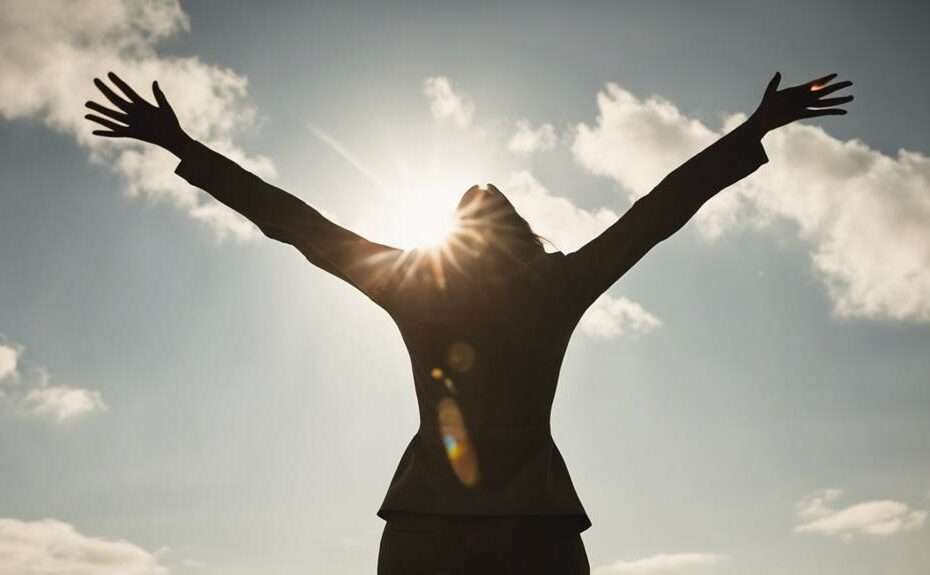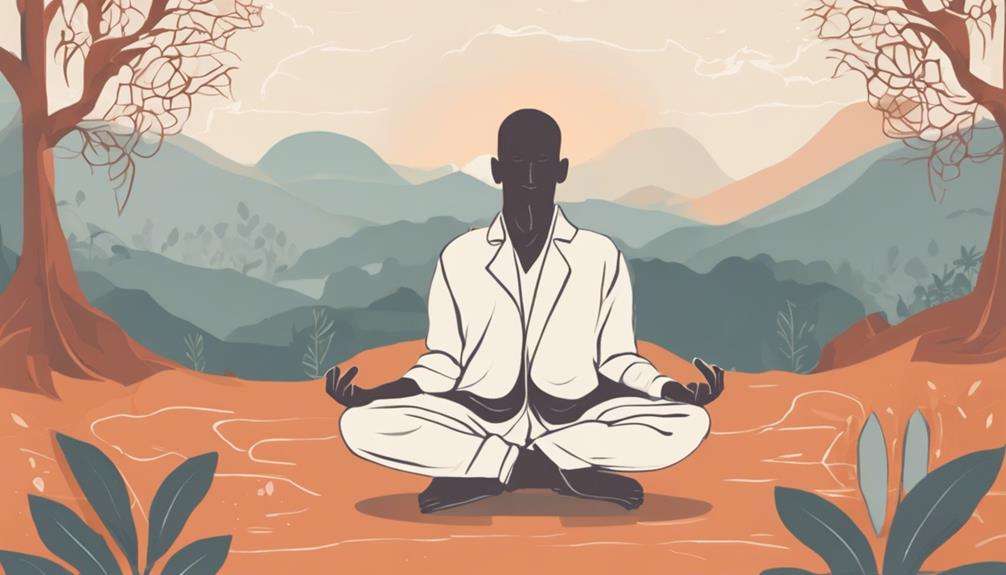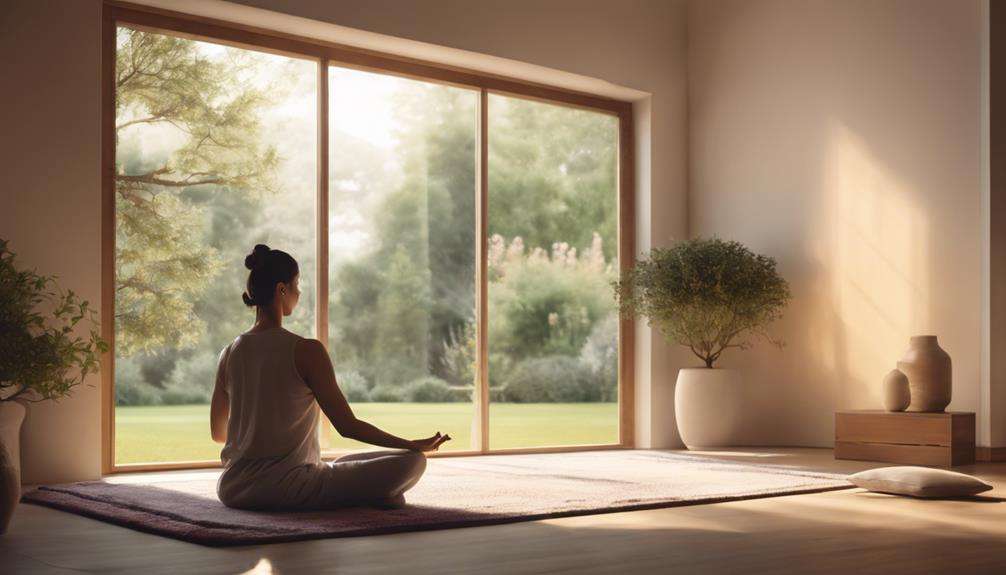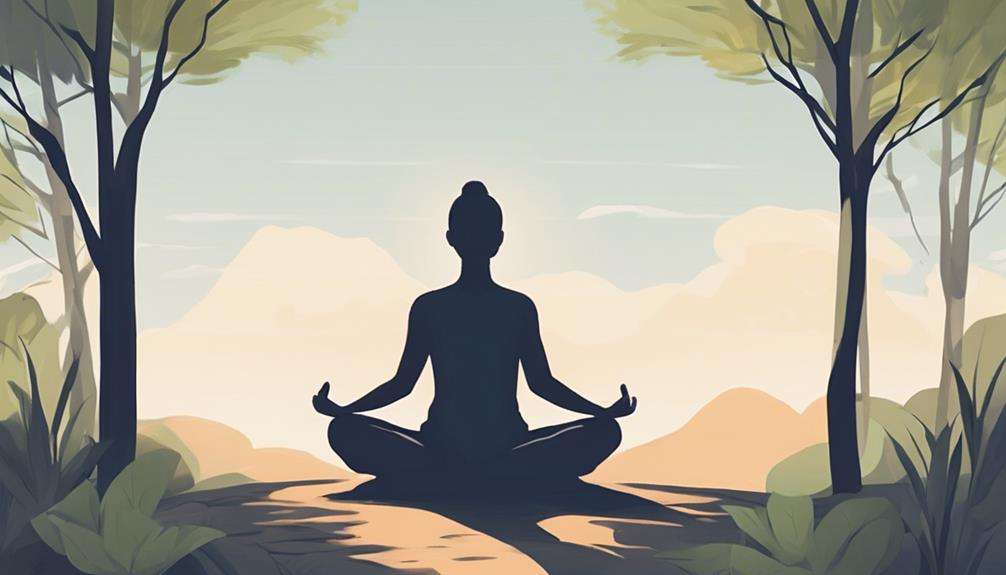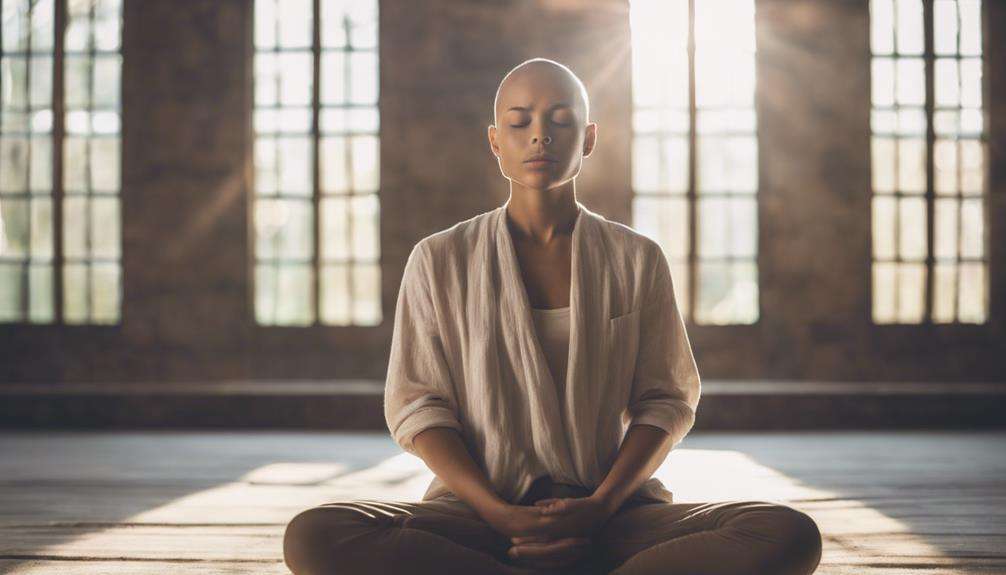To boost your mental alertness, they say, 'A healthy mind in a healthy body.'
Exploring the 10 best poses aimed at enhancing your cognitive sharpness can be a game-changer. These carefully selected yoga postures are not just about physical flexibility but also about sharpening your focus and boosting mental clarity.
As you dive into the world of these poses, you'll discover a whole new dimension of well-being waiting to be explored. Each pose has its unique benefits, offering you a pathway to unlock your mental potential.
Key Takeaways
- Practice Downward Facing Dog to stimulate the nervous system and enhance cognitive function.
- Engage in Child's Pose for mental stillness, stress reduction, and tranquility.
- Incorporate Crescent Lunge Pose for improved balance, stability, and cognitive function.
- Try Garland Pose to aid digestion, stimulate the mind, and enhance mental alertness.
Child's Pose (Balasana)
Child's Pose, also known as Balasana, offers a simple yet powerful way to ground yourself and find calm amidst the chaos of daily life. This calming yoga posture is particularly effective in reducing stress and anxiety by allowing you to connect with your breath and release tension from your body and mind. By practicing deep breathing while in Child's Pose, you can signal to your nervous system that it's time to relax, helping to soothe frayed nerves and promote a sense of tranquility.
The gentle stretch experienced in Balasana as you rest your abdomen on your thighs can help alleviate built-up tension in your lower back and hips, areas where stress often manifests physically. This pose acts as a soothing retreat, giving your mind a break from constant stimulation and allowing for a moment of mental stillness. Regular practice of Child's Pose can be a grounding ritual that supports your overall well-being by fostering a sense of comfort and peace within yourself.
Cat-Cow Pose (Marjaryasana-Bitilasana)
Engaging in Cat-Cow Pose can bring numerous benefits to your overall well-being. By practicing this pose, you can improve spinal flexibility, alleviate back pain, and release tension in key areas like the neck, shoulders, and chest.
Paying attention to proper form and incorporating Cat-Cow Pose into your routine can help you experience a greater sense of balance and harmony in both your body and mind.
Benefits of Pose
Cat-Cow Pose (Marjaryasana-Bitilasana) is a beneficial yoga pose that improves spinal flexibility, promotes blood circulation to the brain, and fosters mental alertness. By engaging in this pose, you actively work on enhancing your back's flexibility and mobility, which can help alleviate stiffness and discomfort.
The gentle stretching of the spine, shoulders, and neck not only increases blood flow to the brain but also aids in relieving stress and anxiety, promoting a sense of calmness. This pose encourages the coordination of movement with breath, which is essential for enhancing mental focus and clarity.
Regular practice of Cat-Cow Pose can significantly boost your ability to concentrate and stay alert throughout the day.
Proper Form Tips
To ensure optimal alignment and maximize the benefits of Cat-Cow Pose (Marjaryasana-Bitilasana), focus on positioning your wrists directly under your shoulders and aligning your knees beneath your hips. Here are some essential tips for proper form in this pose:
- Engage your core muscles to support your body and maintain stability throughout the movement.
- Alternate between arching your back (cow) and rounding it (cat) with each breath to enhance spinal flexibility.
- Sync your breath with the movement to promote mental clarity and reduce stress, fostering a sense of calmness and focus.
Easy Pose (Sukhasana)
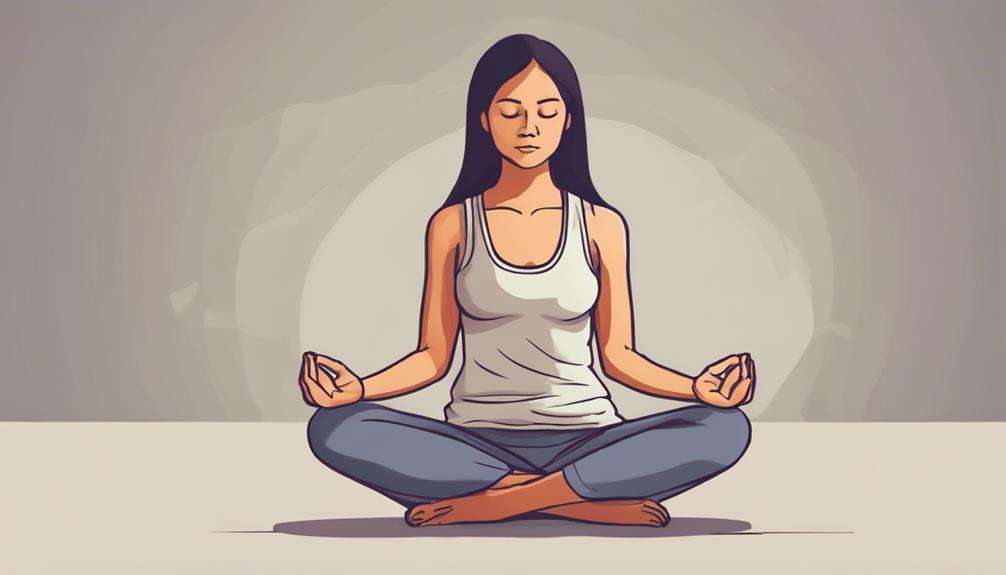
When sitting in Easy Pose (Sukhasana), your body finds a comfortable and grounded position, allowing your mind to focus and relax.
Proper alignment in Sukhasana keeps your spine elongated and your breath flowing smoothly, fostering a sense of calm.
Benefits of Sukhasana
Sukhasana, known as the Easy Pose in yoga, is a foundational posture that cultivates a sense of happiness and relaxation while enhancing mental clarity and overall well-being. This beginner-friendly yoga pose provides a tranquil space for you to unwind and focus on your breath, fostering a state of peace and calmness.
Here are three key benefits of practicing Sukhasana:
- Promotes Relaxation: By sitting cross-legged with a straight spine, Sukhasana creates a serene environment that aids in stress relief and anxiety reduction.
- Enhances Mental Clarity: Deep breathing during Sukhasana allows for improved focus and mental alertness, helping to clear your mind.
- Improves Posture: Regular practice of Easy Pose can assist in correcting posture misalignments and decreasing bodily tension, leading to a more comfortable and aligned body.
Proper Sukhasana Technique
Practicing the Easy Pose (Sukhasana) with proper technique is essential for maximizing its benefits and promoting mental alertness. Sukhasana, also known as Easy Pose, is ideal for calming the mind, reducing stress, and setting a relaxed ambiance for meditation.
To perform Sukhasana correctly, sit with legs crossed, maintaining a straight spine, and resting hands on the knees or thighs. This posture aids in releasing anxiety, tension, and fostering a sense of ease and contentment.
Whether you're a beginner or an experienced yogi, Easy Pose is accessible and offers various benefits for enhancing mental alertness. By incorporating Sukhasana into your routine with the right form, you can harness its full potential for improving focus and relaxation during your practice.
Sukhasana Modifications
To enhance your experience and comfort in the Easy Pose (Sukhasana), consider incorporating modifications that support your hips and knees for better alignment and relaxation.
Here are three modifications to help you make the most of your seated pose:
- Elevate Your Hips: Place a cushion or folded blanket under your sitting bones to elevate your hips slightly. This modification can reduce strain on your knees and lower back, promoting better alignment during Sukhasana.
- Support Your Knees: Use yoga blocks or additional blankets under your knees if you experience discomfort or tightness. Supporting your knees can help maintain a comfortable seated position, allowing for a more grounded and focused practice.
- Engage Your Core: Activate your core muscles by gently drawing your navel towards your spine. This engagement not only supports your lower back but also helps in maintaining proper alignment throughout the pose, enhancing your mental clarity and stability.
Bound Angle Pose (Baddha Konasana)
Bound Angle Pose, also known as Baddha Konasana, is a beneficial yoga posture that opens your hips and groin area, enhancing flexibility and mobility. This pose not only increases physical flexibility but also stimulates the abdominal organs, aiding in digestion and alleviating any discomfort you may feel.
Moreover, practicing Baddha Konasana can help calm your mind and reduce anxiety by promoting deep and mindful breathing. The gentle stretching of the inner thighs and groins in this pose improves blood circulation and energy flow throughout your body, leaving you feeling invigorated and refreshed.
Regularly incorporating Bound Angle Pose into your routine may also assist in managing menstrual discomfort and symptoms of menopause. Embrace the therapeutic benefits of Baddha Konasana to nurture both your body and mind, fostering a sense of balance and well-being in your daily life.
Seated Forward Bend (Paschimottanasana)
Enhancing mental alertness and reducing stress, Seated Forward Bend (Paschimottanasana) is a yoga pose that promotes cognitive function by improving blood circulation to the brain. This seated posture offers a range of benefits for your mental well-being:
- Stress Reduction: By calming the mind and stretching the spine, Seated Forward Bend helps alleviate tension and promotes relaxation, leading to reduced stress levels.
- Improved Blood Circulation: The forward fold in this pose enhances blood flow to the brain, increasing oxygen supply. This boost in circulation aids in better cognitive function and mental clarity.
- Nervous System Stimulation: The gentle inversion in Seated Forward Bend stimulates the nervous system, heightening mental alertness and awareness, which can enhance your overall focus and concentration.
Incorporating Paschimottanasana into your routine can't only improve your physical flexibility but also positively impact your mental well-being, making it a valuable addition to your mindfulness practices.
Half Lord of the Fishes Pose (Ardha Matsyendrasana)
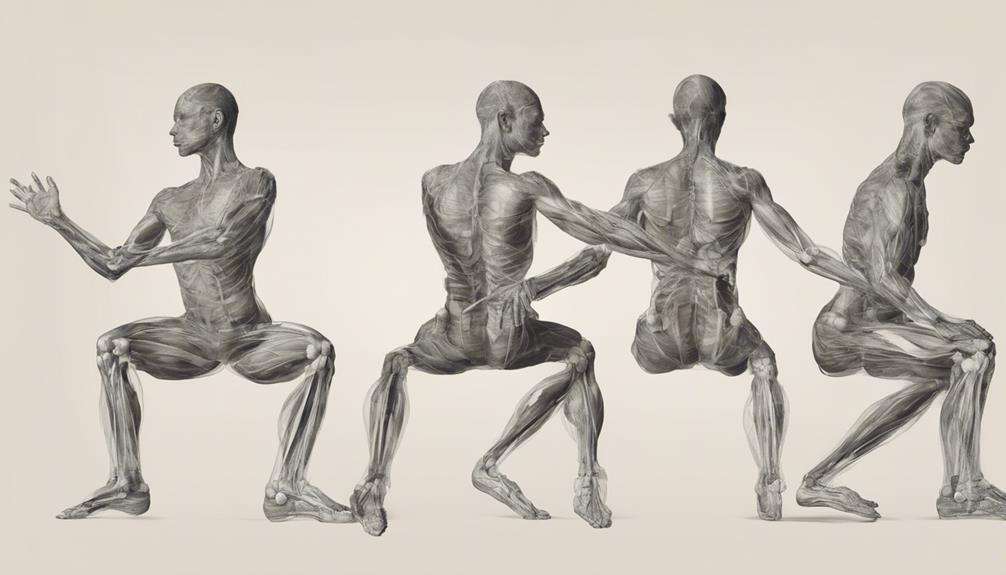
Ardha Matsyendrasana, also known as Half Lord of the Fishes Pose, offers a seated spinal twist that enhances circulation to the spine and improves flexibility. This pose not only benefits your physical body but also plays a crucial role in boosting mental alertness.
By engaging in Ardha Matsyendrasana, you stimulate your digestive organs, aiding in detoxification and enhancing digestion. The twisting motion also strengthens the muscles along your spine and obliques, promoting core stability.
Moreover, by massaging the abdominal organs, this pose can help relieve constipation and improve overall gut health. Consistent practice of Ardha Matsyendrasana can release tension in your back, shoulders, and neck, leading to improved mental clarity.
Downward Facing Dog Pose (Adho Mukha Svanasana)
When practicing the Downward Facing Dog Pose (Adho Mukha Svanasana), it's important to focus on the benefits it offers and ensure proper alignment for maximum impact. Strengthening your arms, shoulders, and legs, this pose can boost circulation and enhance blood flow to your brain.
Benefits of the Pose
Engage your entire body and boost mental alertness with the powerful benefits of the Downward Facing Dog Pose (Adho Mukha Svanasana). This pose enhances blood flow to the brain, improving mental alertness and focus.
Here are three key benefits of practicing Downward Facing Dog:
- Enhanced Brain Function: By stimulating the nervous system, this pose helps sharpen concentration and cognitive function.
- Increased Energy Levels: Elongating the spine and engaging the core in Adho Mukha Svanasana boosts energy levels and promotes mental clarity.
- Improved Mental Alertness: Regular practice of Downward Facing Dog can enhance overall brain function, keeping your mind sharp and focused throughout the day.
Unlock the potential of your mind and body with this energizing yoga pose.
Proper Alignment Tips
To achieve optimal alignment in the Downward Facing Dog Pose (Adho Mukha Svanasana), focus on grounding your palms firmly on the mat and spreading your fingers wide. Engage your core muscles to lift the tailbone up and press your heels towards the mat, ensuring alignment from your wrists to your hips.
Keep your shoulders away from your ears, creating space between your shoulder blades while lengthening your spine from your hands to your tailbone. Align your ears with your upper arms and gaze towards your navel to prevent neck strain and maintain proper alignment.
Crescent Lunge Pose (Anjaneyasana)
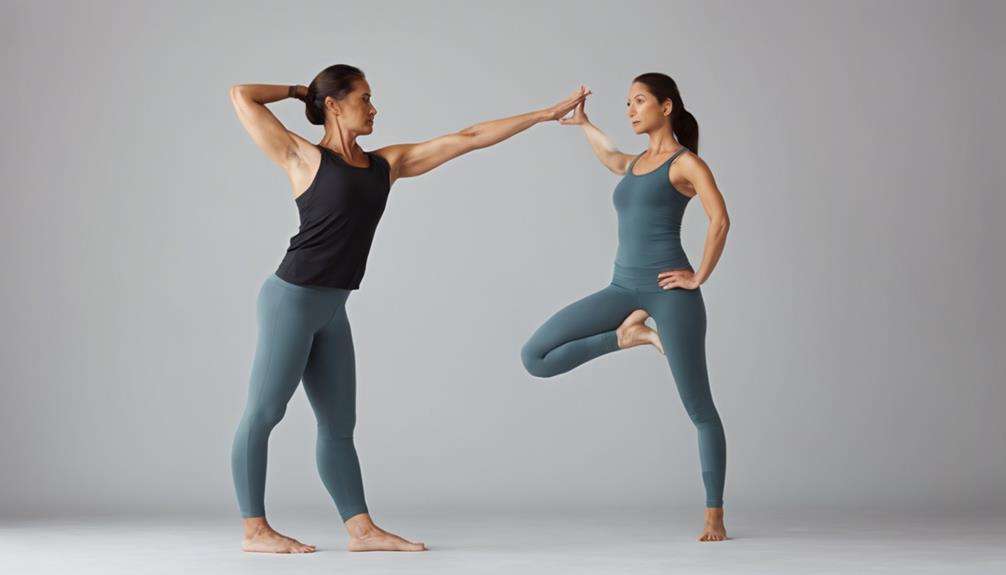
Stretching and strengthening the legs, hips, and core muscles, Crescent Lunge Pose, also known as Anjaneyasana, is a dynamic posture that engages the entire body to enhance balance, stability, and focus. This powerful yoga pose not only works on your physical strength but also plays a significant role in sharpening your mental faculties.
Here are three key benefits of practicing Crescent Lunge Pose:
- Improved Balance and Focus: By challenging your body to maintain the pose, you train your mind to concentrate and stay present, thus enhancing your overall focus and balance.
- Deep Breathing for Mental Alertness: Anjaneyasana opens up the chest and lungs, allowing for deeper breaths. This increased oxygen intake boosts mental alertness and clarity, helping you feel more energized and focused.
- Enhanced Cognitive Function: The dynamic nature of Crescent Lunge Pose stimulates both your body and mind, promoting cognitive function and mental sharpness. Regular practice can lead to improved cognitive abilities and heightened alertness throughout the day.
Standing Forward Bend (Uttanasana)
Stimulating the nervous system and enhancing mental clarity, Standing Forward Bend (Uttanasana) is a calming yoga pose that increases blood flow to the brain. This gentle inversion not only boosts energy levels but also helps relieve stress, promoting a sense of calm and focus.
By stretching the spine and hamstrings, Uttanasana stimulates the brain, enhancing mental alertness and cognitive function. The increased circulation to the head can leave you feeling refreshed and more alert.
Regular practice of Standing Forward Bend can contribute to improved mental well-being, as it allows for a moment of introspection and relaxation. So, the next time you need a mental pick-me-up, consider incorporating Uttanasana into your routine to reap its benefits for both the body and mind.
Garland Pose (Malasana)

Enhancing both physical flexibility and mental sharpness, Garland Pose (Malasana) offers a comprehensive workout for your body and mind. Malasana, also known as Garland Pose, combines physical benefits with mental stimulation, making it an excellent addition to your routine. Here's why you should consider incorporating this pose into your practice:
- Improved Digestion: By practicing Malasana, you can aid digestion and promote better gastrointestinal health. The pose helps stimulate the abdominal organs, facilitating the digestive process and reducing bloating or discomfort.
- Strengthened Lower Body: Malasana works to strengthen the lower body, targeting muscles in the thighs and calves. This can contribute to improved stability, balance, and overall lower body strength.
- Enhanced Mental Alertness: Regular practice of Malasana can boost mental alertness and focus. The combination of physical movement and mindful breathing in this pose helps clear the mind and increase cognitive function, leading to improved mental acuity throughout the day.
Frequently Asked Questions
What Yoga Pose Is Good for Brain Fog?
For brain fog, a yoga pose that can help is the Standing Forward Bend. This pose enhances blood circulation to the brain, improving mental alertness. Incorporate this into your practice for a clearer mind.
Which Asana Is Best for Mental Concentration?
For enhancing mental concentration, try Padmasana (Lotus Pose). This pose calms the mind, enhances focus, and prepares you for deep meditation. Regular practice strengthens the spine and upper back, aiding in sharpening the mind.
What Yoga Poses Increase Dopamine Levels?
To increase dopamine levels, engage in yoga poses like Wheel and Camel. These poses release dopamine, boosting mood and mental alertness. Stimulate the brain with muscle-engaging poses to support cognitive function and overall mental well-being.
Which Yoga Is Best for Brain Power?
For enhancing brain power, consider yoga poses like Padmasana and Vajrasana. Improve cognitive function with Ardha Matsyendrasana and Paschimottanasana. Prevent brain degeneration and enhance focus through Halasana and Mayurasana. Boost brain power and mental clarity with Sirsasana and Bhramari Pranayama.
Conclusion
As you flow through these poses, you aren't just moving your body, but also sharpening your mind. The mental clarity and focus gained from practicing these poses can help you tackle challenges with ease and approach life with a sense of mindfulness.
Just like a well-tuned instrument, your mind will be ready to play the symphony of life with precision and grace.
Keep practicing, keep breathing, and keep shining bright.
